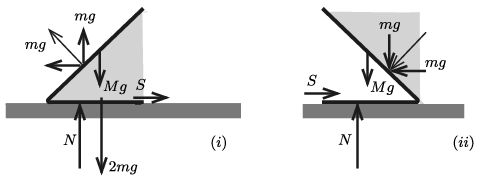 Problem P. 5403. (April 2022)
Problem P. 5403. (April 2022)
P. 5403. Someone suggested building a mobile dam from iron sheets: a horizontal one and another which is attached to it and is tilted at an angle of \(\displaystyle 45^\circ\). The length of the edges of the sheets which are perpendicular to the common intersection line of the two sheets are 1 metre and \(\displaystyle \sqrt2\) metres, and the width of the iron sheets is 2 cm. ``This structure is pressed against the ground not only by the weight of the iron plates but also by the pressure of the water'' – argued the inventor.
\(\displaystyle a)\) What is the least value of the coefficient of static friction between the mobile dam and the ground in order that the dam should be able to protect safely even if the water level is maximum (that is: the level of the water reaches the top edge of the slant iron sheet)?
\(\displaystyle b)\) Where is the point of application of the vertical normal force exerted by the ground on the mobile barrier of this shape, if we use iron sheets having a thickness less than 2 cm or more than 2 cm? Can the mobile dam overturn in the case of the highest water level (i.e. when the water just to the top of the tilted iron plate)?
Investigate the two options for installing the mobile dam:
\(\displaystyle (i)\) the tilted surface slopes towards the water;
\(\displaystyle (ii)\) the tilted surface slopes towards the area to be protected (see the figure).

(5 pont)
Deadline expired on May 16, 2022.
Sorry, the solution is available only in Hungarian. Google translation
Megoldás. \(\displaystyle a)\) Jelöljük a mobilgát 1 méter hosszú szakaszának tömegét \(\displaystyle M\)-mel, a ferde rész alatti, illetve feletti víz tömegét pedig \(\displaystyle m\)-mel, a fémlap vastagságát \(\displaystyle d\)-vel, a vízszint legnagyobb magasságát \(\displaystyle \ell\)-lel (ami megegyezik a mobilgát talajon fekvő részének szélességével).
A megadott adatokból és az ismert anyagi állandókból kiszámíthatjuk, hogy
\(\displaystyle M=(1+\sqrt2)\ell d \varrho_\text{vas}\cdot \text{(1 méter)}=2{,}41\cdot 0{,}02\cdot 7860\ {\rm kg}\approx 380\ \rm kg,\)
\(\displaystyle m=\frac12 \ell^2\varrho_\text{víz}\cdot \text{(1 méter)}=500\ \rm kg.\)
Az ábrán a vaslemezre ható erőket ábrázoltuk, a talaj nyomóerejét \(\displaystyle N\)-nel, a súrlódási erőt pedig \(\displaystyle S\)-sel jelöltük.
\(\displaystyle (i)\) eset. A víz függőleges irányban összesen \(\displaystyle mg\) erőt fejt ki a mobilgátra. A vízszintes vaslapra ható, a víz nyomásából származó erő \(\displaystyle 2mg\) (hidrosztatikai paradoxon), tehát a ferde lapra a víz függőlegesen \(\displaystyle mg\) erőt kell, hogy kifejtsen. De mivel a ferde lapra ható eredő erő a \(\displaystyle 45^\circ\)-os szögben álló vaslapra merőleges, ennek az erőnek a vízszintes komponense is \(\displaystyle mg\). A vízszintes és a függőleges erők egyensúlyából következik, hogy
\(\displaystyle S=mg, \qquad \text{továbbá} \qquad N=Mg+mg.\)
Mivel \(\displaystyle S\le \mu N,\) a súrlódási együttható legkisebb értéke (ami mellett még nem csúszik meg a gát):
\(\displaystyle \mu_\text{min}=\frac{S}{N}=\frac{m}{m+M}\approx \frac{500}{500+380}=0{,}57.\)

\(\displaystyle (ii)\) eset. A víz most is ugyanolyan nyomással hat a ferde lapra, viszont a víz nyomásából származó erő nem ,,emeli'', hanem ,,leszorítja'' a ferde lapot. A lapra merőleges nyomóerőnek mind a függőleges, mind a vízszintes összetevője \(\displaystyle mg\), a vízszintes lemezre viszont nem hat a hidrosztatikai nyomás, hiszen közvetlenül felette nincs is víz. Most is igaz, hogy \(\displaystyle S=mg\) és \(\displaystyle N=Mg+mg.\) A súrlódási együttható legkisebb értéke ugyanakkora, mint az előző esetben: \(\displaystyle \mu_\text{min}\approx 0{,}57.\)
Megjegyzés. Ilyen nagy súrlódás a nedves, felázott talaj és a vaslap között aligha létezik. A ténylegesen megépített, hasonló szerkezetű mobilgátaknál a vízszintes vaslapból függőleges ,,tüskék'' nyúlnak ki, és ezek a talajba mélyedve megakadályozzák a gát elcsúszását.
\(\displaystyle b)\) Számítsuk ki az \(\displaystyle N\) erő hatásvonalának a vaslapok törésvonalától mért \(\displaystyle x\) távolságát. Felhasználjuk, hogy a folyadék hidrosztatikai nyomásából származó eredő erő támadáspontja a folyadék alsó egyharmadánál van.
A mobilgátra ható erők forgatónyomatékának egyensúlyából megkaphatjuk \(\displaystyle x\) értékét. A gát feldőlés szempontjából akkor stabil, ha \(\displaystyle 0<x<\ell\).
Az \(\displaystyle (i)\) esetben fennáll, hogy
\(\displaystyle x(mg+Mg) +\frac{\ell}3mg +\frac{\ell}3mg=\frac{\ell}2(2m+M)g,\)
vagyis
\(\displaystyle x=\frac{\frac12 +\frac{m}{3M}}{1+\frac{m}{M} }\ell\approx 0{,}4\ \rm m.\)
Ez a távolság más vastagságú vaslemez (tehát más \(\displaystyle M\) tömeg, vagyis más \(\displaystyle \frac{m}{M}\) arány) esetén biztosan \(\displaystyle \frac13\ell\) és \(\displaystyle \frac12\ell\) közé esik, tehát a gát nem borulhat fel.
A \(\displaystyle (ii)\) esetben felírhatjuk, hogy
\(\displaystyle x(mg+Mg) -\frac{\ell}3mg -\frac{\ell}3mg=\frac{\ell}2Mg,\)
ahonnan
\(\displaystyle x=\frac{\frac12 +\frac{2m}{3M}}{1+\frac{m}{M} }\ell\approx 0{,}6\ \rm m.\)
Tetszőleges tömegarány mellett érvényes, hogy
\(\displaystyle \frac12\ell<x<\frac23\ell,\)
tehát a gát ebben az esetben sem borulhat fel.
Statistics:
12 students sent a solution. 5 points: Gábriel Tamás, Kertész Balázs, Téglás Panna, Toronyi András, Vig Zsófia, Waldhauser Miklós. 3 points: 1 student. 2 points: 2 students. 1 point: 1 student. 0 point: 2 students.
Problems in Physics of KöMaL, April 2022
